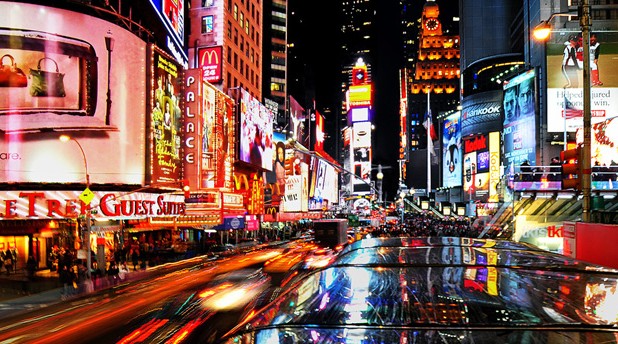New York City: Central Park

New York City’s Central Park is a vibrant, colorful attraction for tourists and locals alike. The park occupies over 840 acres in Manhattan and receives over 25 million visitors annually. It is bordered to the north by West 110th Street, to the west by Central Park West, to the south by West 59th Street, and to the east by the famous 5th Avenue. Though it appears natural, Central Park, designed by Frederick Law Olmstead and Calvert Vaux, is entirely landscaped with artificial lakes, a zoo, playgrounds, walking trails, and ice skating rinks.
In the mid-nineteenth century, New York City was growing at an unprecedented rate. Public open spaces, aside from cemeteries, were few and far between. Poet William Cullen Bryant, among others, began to voice a need for a larger, sanctioned public park. In 1953, New York Legislature designated over 700 acres of land to be used for a park, for a cost of about 5 million dollars. A design contest was held, and Olmstead and Vaux’s “Greensward Plan” was chosen. However, after the park’s construction, public interest waivered and the park declined quickly after it was built; the political powers in New York City at the time were not interested in maintaining a 700 acre public facility.
In 1934, mayor Fiorello LaGuardia appointed Robert Morris to restore and revitalize Central park. The park underwent major construction and redesigning; athletic fields were constructed and the walking trails were adjusted for automobiles. In the 1960s, the park thrived as a symbol for counter-culture events and urban revival. Many rock concerts, political events, and Shakespearean plays took place in Central Park. In 1963, it was declared a national historic landmark. Unfortunately, due to budget cuts in the 1970s, the park suffered another rapid decline. It was restored again in the 1980s and early 1990s, and remains a lively entertainment mecca today.
Central Park’s place in pop culture is secure. Legendary folk singers Paul Simon and Art Garfunkel played a reunion concert at Central Park, and subsequently released a recording of it that went on to be one of their best-selling albums. In recent years, the Park has hosted a variety of music festivals, including the extremely popular Dave Matthews Band. It was featured in the James Bond film Live and Let Die, as well as Madagascar. J.D. Salinger’s coming-of-age novel is partially set in Central Park, while Edward Albee’s drama The Zoo Story is completely set in Central Park; there is even a playground named after Diana Ross. Perhaps the most culturally significant pop culture aspect of Central Park is Strawberry Fields.
(adsbygoogle = window.adsbygoogle || []).push({});
....read more
Essential New York: An Overview Of Midtown Manhattan

Midtown Manhattan contains the most popular tourist destinations in New York City and is the single busiest commercial district in the United States. This section of New York City includes the area between 14th Street and 59th Street from the East River to the Hudson River; the “heart” of Midtown is from 31st Street to 59th Street between Third and Ninth Avenues.
Manhattan was originally settled by the Lenape. In 1624, a permanent European presence settled on the island; one of the Dutch East India Company’s explorers, Henry Hudson, was the first to successfully map the region. The land was named Fort Amsterdam and the natives sold it for $24; 1625 is now recognized as the birth date of New York City. The British conquered the settlement in 1664 and renamed it “New York” after the English Duke of York. From January 11, 1785 to the Fall of 1788, New York City was one of the capitals of the country under the Articles of Confederation; New York was America’s fist capital city under our Declaration of Independence.
The nineteenth century population explosion made Midtown Manhattan the center of commerce for the entire area. During the Great Depression and between the World Wars, Midtown saw a lot of art deco buildings erected, in particular, the Empire State Building, which was the tallest building in the world at that time. Today, it is the tallest building in New York after the demise of the World Trade Centers, and the second tallest building in the country.
Today’s Midtown includes a variety of vibrant, eclectic neighborhoods: Gramercy, a relatively quiet area; Hell’s Kitchen, which figured prominently in New York City’s organized crime; Chelsea, a very gay-friendly area and a center of art and night life; Murray Hill, formerly a stiff and professional area, recently becoming a nightlife haven; Turtle Bay, where the UN Headquarters is located; Rockefeller Center, site of the famous Christmas tree, the Theatre District, famous for the many Broadway theatres in the area; the Meatpacking District, once an undesirable location is now one of the hottest nightclub spots in Manhattan; Koreatown, affectionately called “K-Town” by the locals; Times Square is one of the busiest tourist destinations in the entire world; the Garment District, the center for fashion design and manufacturing; and Herald Square, a hub for retail shopping.
Most of the famous New York City tourist attractions are located in Midtown Manhattan: The Museum of Modern Art, or the MoMA, is one of the foremost museums of modern art in the world. The largest gothic-style Catholic Church in the United States is St. Patrick’s Cathedral, located on Madison Avenue. Nearby is high-end retailer Saks Fifth Avenue’s flagship store. Legendary concerts and sporting events happen nightly at Madison Square Garden. The New York Public Library, one of the world’s best research institutions, has various locations throughout Midtown. Midtown Manhattan is absolutely packed with restaurants, bars, and just about anything for individuals of all ages.
Midtown Manhattan is a bustling metropolis for both tourists and locals. It’s easy ....read more

Follow Us: